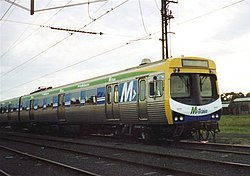
The City Loop is a piece of underground commuter rail infrastructure in the central business district (CBD) of Melbourne, Victoria, Australia

Parliament railway station is a commuter railway station adjacent to the border between the Melbourne CBD and the suburb of East Melbourne, in Victoria, Australia. The station has two island platforms in a two-floor configuration, connected to street level via two underground concourses.

Yarra Trams is the trading name of the operator of the tram network in Melbourne, Australia, which is owned by VicTrack and leased to Yarra Trams by the Victorian Department of Transport and Planning. The current franchise is operated by Keolis Downer. As at May 2014, Yarra Trams operate 487 trams, across 26 tram routes and a free City Circle tourist tram, over 1,763 tram stops. With 250 km (155.3 mi) of double track, Melbourne's tram network is the largest in the world.

Caulfield railway station is a commuter railway station on the northern boundary of Caulfield East, a suburb of Melbourne, Victoria, Australia. Opened in 1879 and rebuilt from 1913 to 1914, the station complex is listed on the Victorian Heritage Register and is noted as an example of Federation Free Style architecture. It is named after the nearby suburb of Caulfield, located southwest of the station.

North Melbourne railway station is the junction for the Craigieburn, Flemington Racecourse, Sunbury, Upfield, Werribee and Williamstown lines in Victoria, Australia. It serves the inner-northern Melbourne suburb of West Melbourne, and opened on 6 October 1859.

The Frankston line is a commuter railway line in the city of Melbourne, Victoria, Australia. Operated by Metro Trains Melbourne, it is the city's third-longest metropolitan railway line, at 42.7 kilometres (26.5 mi). The line runs from Flinders Street station in central Melbourne to Frankston station in the south-east, serving 28 stations via South Yarra, Caulfield, Moorabbin, and Mordialloc. The line continues to Stony Point on the non-electrified Stony Point line. The line operates for approximately 20 hours a day with 24 hour service available on Friday and Saturday nights. During peak hour, headways of up to 5 to 10 minutes are operated with services every 10–20 minutes during off-peak hours. Trains on the Frankston line run with a two three-car formations of Comeng, Siemens Nexas, and X'Trapolis 100 trainsets.
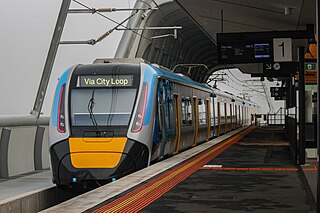
The Pakenham line is a commuter railway line in the city of Melbourne, Victoria, Australia. Operated by Metro Trains Melbourne, it is the city's longest metropolitan railway line at 57 kilometres (35 mi). The line runs from Flinders Street station in central Melbourne to Pakenham station in the south-east, serving 27 stations via the City Loop, South Yarra, Caulfield, Oakleigh, and Dandenong. The line operates for approximately 20 hours a day with 24 hour service available on Friday and Saturday nights. During peak hour, headways of up to 5 to 10 minutes are operated with services every 20 minutes during off-peak hours. Trains on the Pakenham line run with a seven-car formation operated by High Capacity Metro Trains.

The Sandringham line is a commuter railway line in the city of Melbourne, Victoria, Australia. Operated by Metro Trains Melbourne, it is the city's fourth shortest metropolitan railway line at 17.9 kilometres (11.1 mi). The line runs from Flinders Street station in central Melbourne to Sandringham station in the south-east, serving 14 stations via South Yarra, Balaclava, Elsternwick, and Brighton. The line operates from approximately 5am to 12am, daily, with 24 hour service available on Friday and Saturday nights. Services run every 7–8 minutes during peak hour, with services running every 15 minutes during the inter-peak period on weekdays, and every 20 minutes at night and during the day on weekends. Additionally, services run every 60 minutes overnight on Friday and Saturday nights as part of the Night Network.

The Cranbourne line is a commuter railway line in the city of Melbourne, Victoria, Australia. Operated by Metro Trains Melbourne, it is the city's second longest metropolitan railway line at 44 kilometres (27 mi). The line runs from Flinders Street station in central Melbourne to Cranbourne station in the south-east, serving 24 stations via the City Loop, South Yarra, Caulfield, Oakleigh, and Dandenong. The line operates for approximately 20 hours a day with 24 hour service available on Friday and Saturday nights. During peak hour, headways of up to 5 to 15 minutes are operated with services every 15–20 minutes during off-peak hours. Trains on the Cranbourne line run with a seven-car formation operated by High Capacity Metro Trains.

The Williamstown Line is a commuter railway line in the city of Melbourne, Victoria, Australia. Operated by Metro Trains Melbourne, it is the city's third shortest metropolitan railway line at 16.2 kilometres (10.1 mi). The line runs from Flinders Street station in central Melbourne to Williamstown station in the inner west, serving 12 stations via Footscray, Yarraville, and Newport. The line operates for approximately 19 hours a day with 24-hour service available on Friday and Saturday nights. During peak hours, the line operates with headways of up to 20 minutes, ensuring frequent service for commuters. During off-peak hours, the service intervals are adjusted to provide service every 20–30 minutes, accommodating the lower demand. Trains on the Williamstown Line run with two three-car formations of Comeng, Siemens Nexas, and X'Trapolis 100 trainsets.
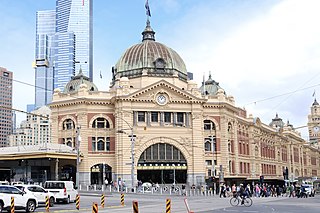
The Melbourne rail network is a metropolitan suburban and freight rail system serving the city of Melbourne, Victoria, Australia. The metropolitan rail network is centred around the Melbourne central business district (CBD) and consists of 222 railway stations across 16 lines, which served a patronage of 99.5 million over the year 2021–2022. It is the core of the larger Victorian railway network, with regional links to both intrastate and interstate rail systems.

Connex Melbourne was a train operator in Melbourne, Australia. Formed in July 1998 as Hillside Trains, a business unit of the Public Transport Corporation, it was privatised in August 1999 becoming a subsidiary of Connex.

The Stony Point line is a greater-metropolitan commuter railway line in the city of Melbourne, Victoria, Australia. Operated by Metro Trains Melbourne, it is the city's only diesel service on the metropolitan network and the tenth longest line at 31 kilometres (19 mi). The line acts as an extension of the Frankston line with services running from Frankston station to the small town of Stony Point in the south-east, serving 10 stations via Leawarra, Baxter, Hastings, and Bittern. The line operates for approximately 13 hours a day, unlike other lines on the network, which provide 24-hour service on Friday and Saturday nights. Headways of 90 to 120 minutes are operated throughout the day due to limited patronage and infrastructure constraints. Trains on the Stony Point line run as two one-car formations of V/Line Sprinters.
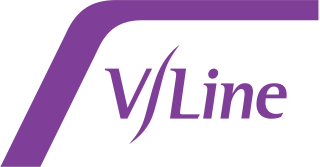
V/Line is a statutory authority that operates regional passenger train and coach services in the Australian state of Victoria. It provides passenger train services on five commuter lines and eight long-distance routes from its major hub at Southern Cross railway station in Melbourne. It also provides bus services across Victoria and into New South Wales, the Australian Capital Territory and South Australia. In addition, V/Line is responsible for the maintenance of much of the Victorian freight and passenger rail network outside of the areas managed by Metro Trains Melbourne and the Australian Rail Track Corporation.

The Craigieburn line is a commuter railway line in the city of Melbourne, Victoria, Australia. Operated by Metro Trains Melbourne, it is the city's sixth shortest metropolitan railway line at 27.0 kilometres (16.8 mi). The line runs from Flinders Street station in central Melbourne to Craigieburn station in the north, serving 21 stations via North Melbourne, Essendon, and Broadmeadows. The line operates for approximately 19 hours a day with 24 hour service available on Friday and Saturday nights. During peak hour, headways of up to 5 minutes are operated with services every 20–30 minutes during off-peak hours. Trains on the Craigieburn line run with a two three-car formations of Comeng or Siemens Nexas trainsets.

Coolaroo railway station is located on the Craigieburn line in Victoria, Australia. It serves the northern Melbourne suburb of Coolaroo, and it opened on 6 June 2010.
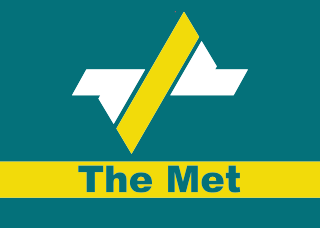
The Public Transport Corporation (PTC) was a Victoria State Government owned statutory authority formed under the Transport Act 1983 which operated passenger and freight trains, trams and bus services.

The Metropolitan Transit Authority (MTA), known to the general public as The Met, was a Government of Victoria owned corporate body that operated suburban passenger trains, trams and buses in Victoria, Australia. It was set up under Section 15 of the Transport Act 1983 and commenced operation on 1 July 1983. It was a statutory body set up to manage the trams formerly operated by the Melbourne & Metropolitan Tramways Board, the metropolitan train operations of the former VicRail, and the operations of the former Melbourne Underground Rail Loop Authority.
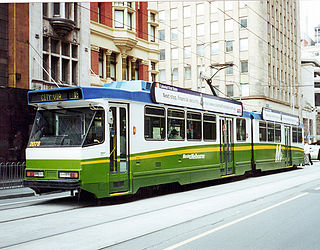
M>Tram was a tram operator in Melbourne, Australia. Formed in July 1998 as Swanston Trams, a business unit of the Public Transport Corporation, it was privatised in August 1999 becoming a subsidiary of National Express. In December 2002 National Express handed the franchise in, with the State Government taking over until negotiations were concluded for Yarra Trams to take over in April 2004.
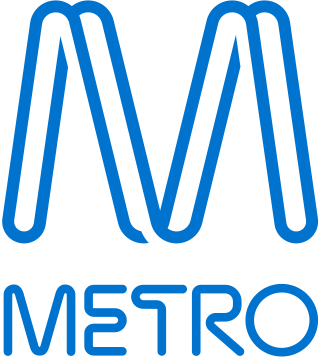
Metro Trains Melbourne, often known simply as Metro, is the operator and brand name of train services on the electrified metropolitan rail network serving the city of Melbourne, Victoria, Australia. It is the largest urban rail network in Australia, with 17 lines and 221 stations across 405 km (252 mi) of railways, and the second busiest network in Australia, with a patronage of 99.5 million as of 2021–2022.

